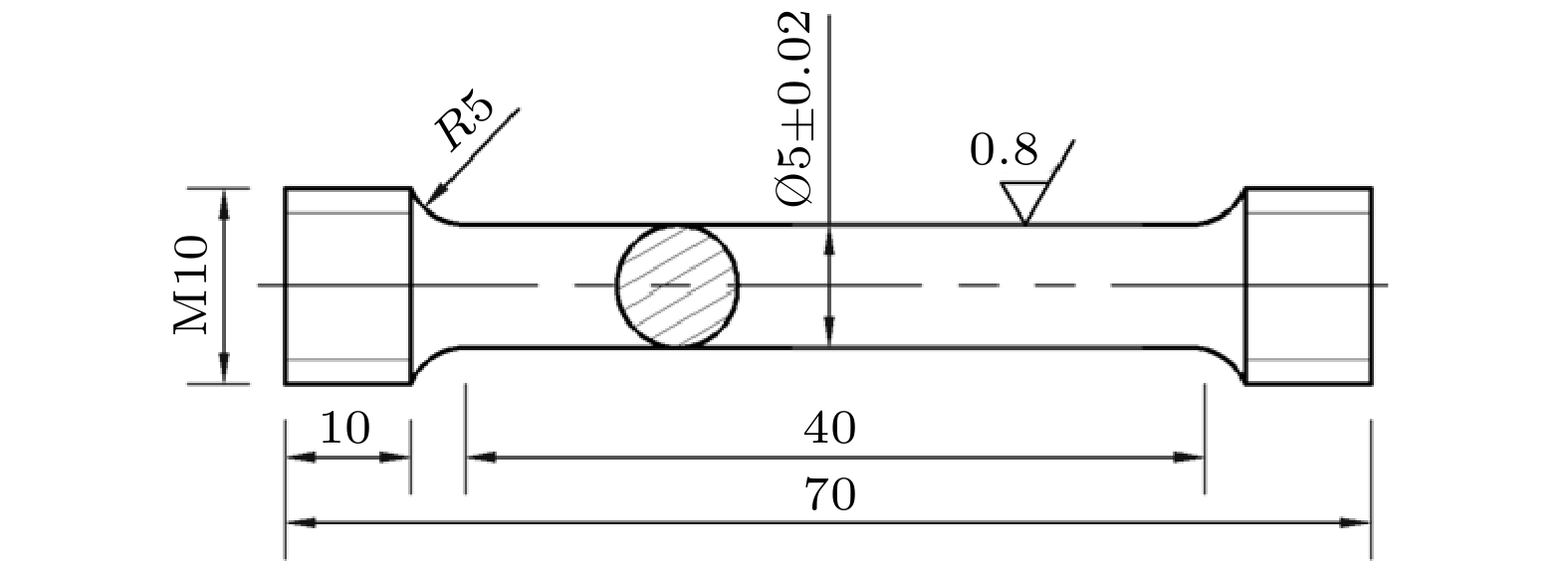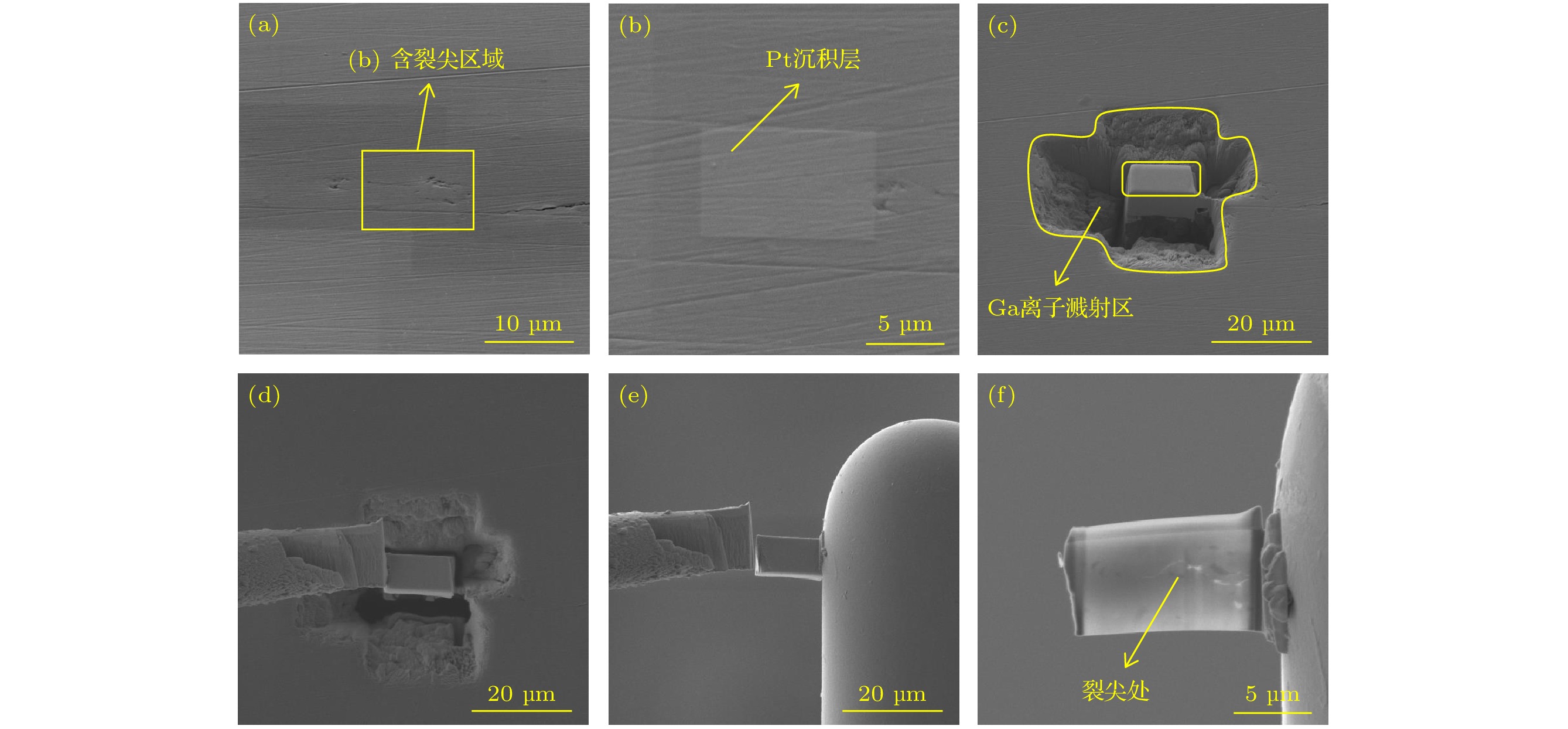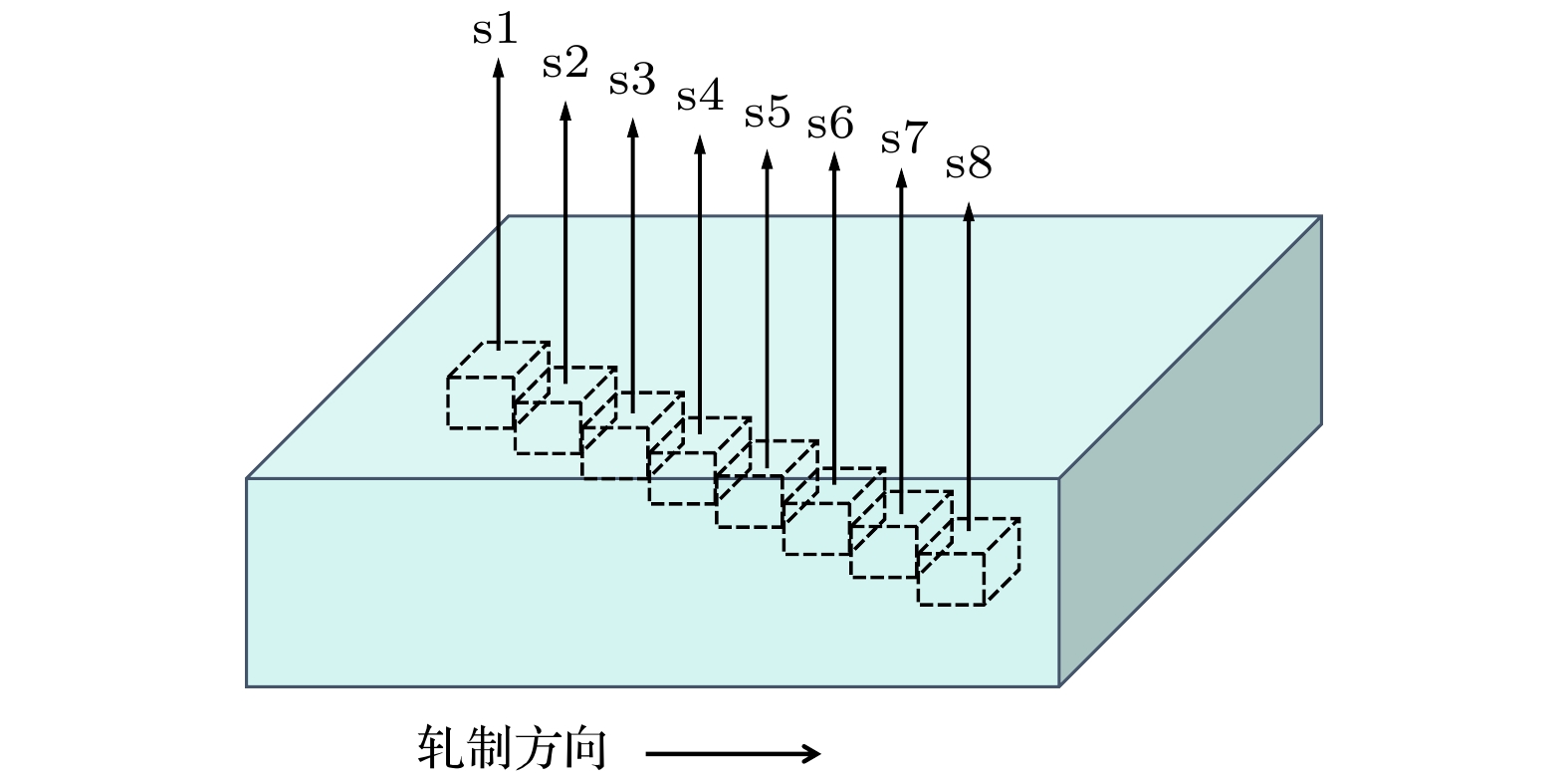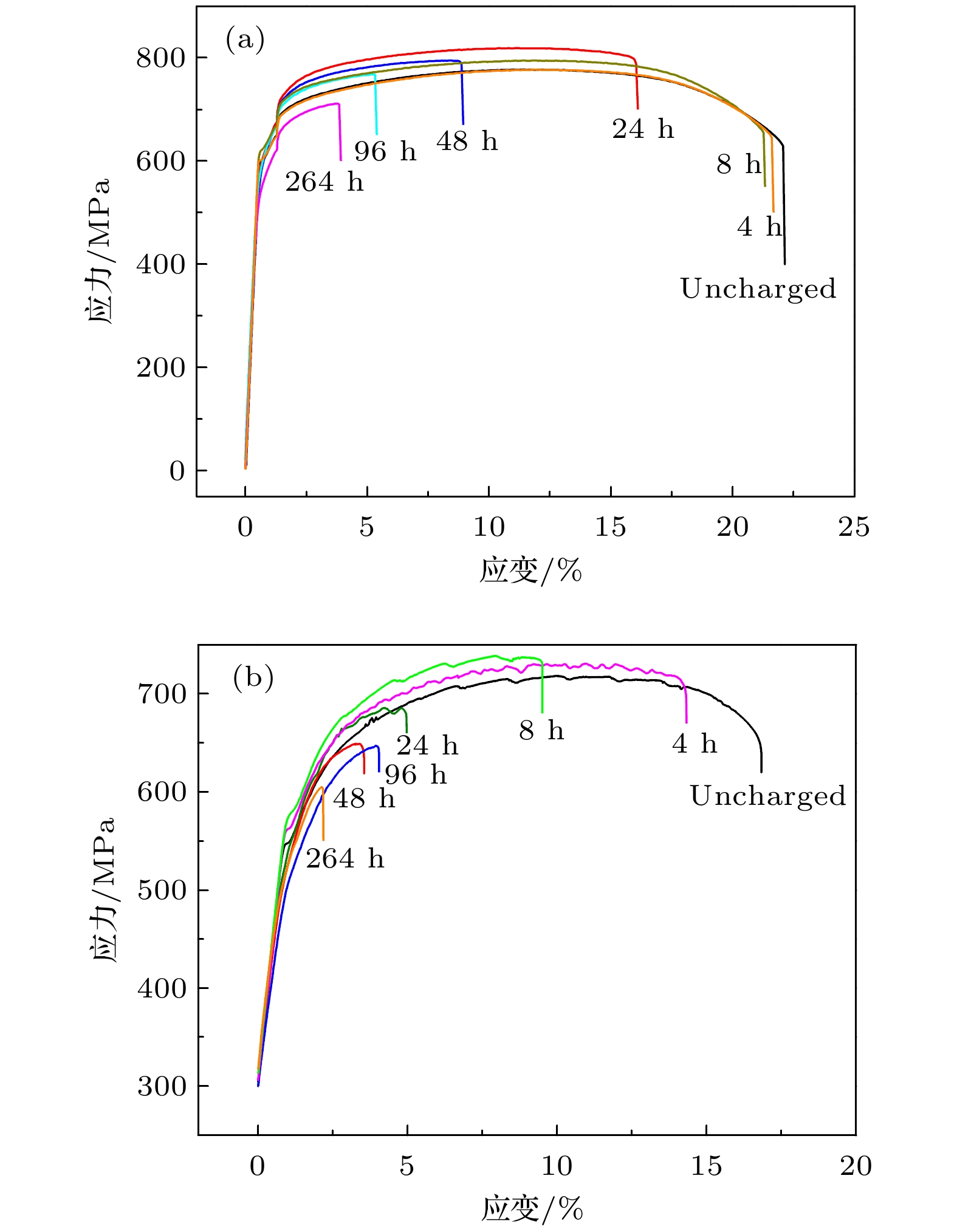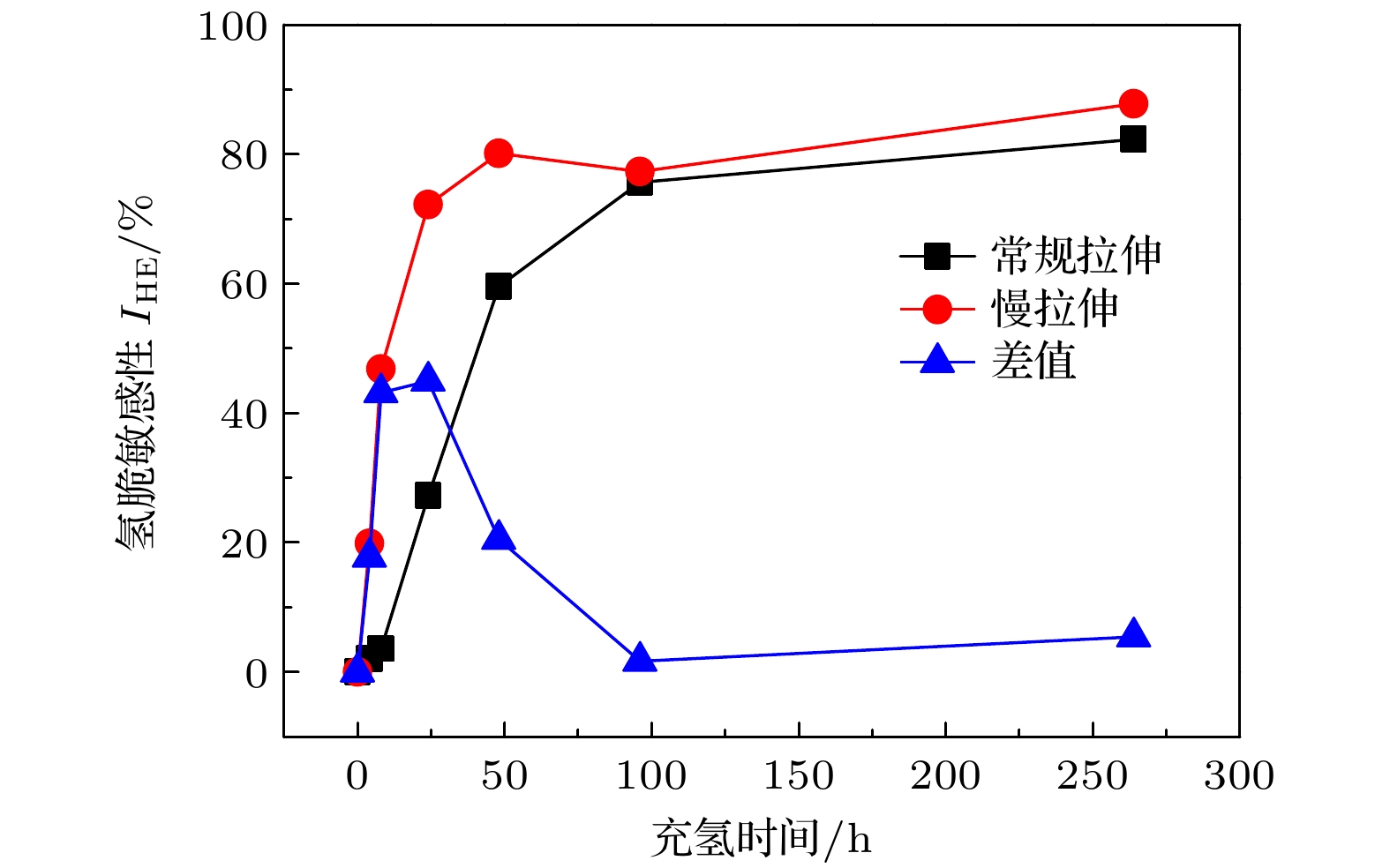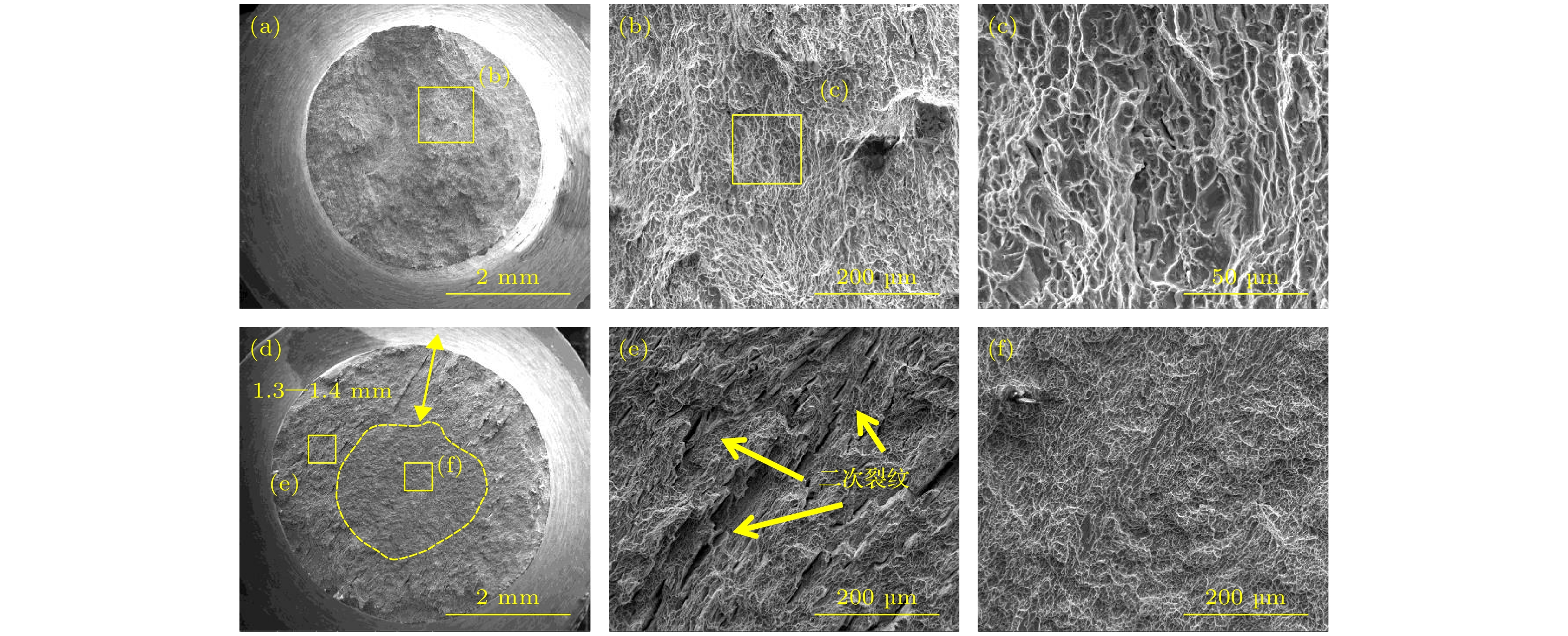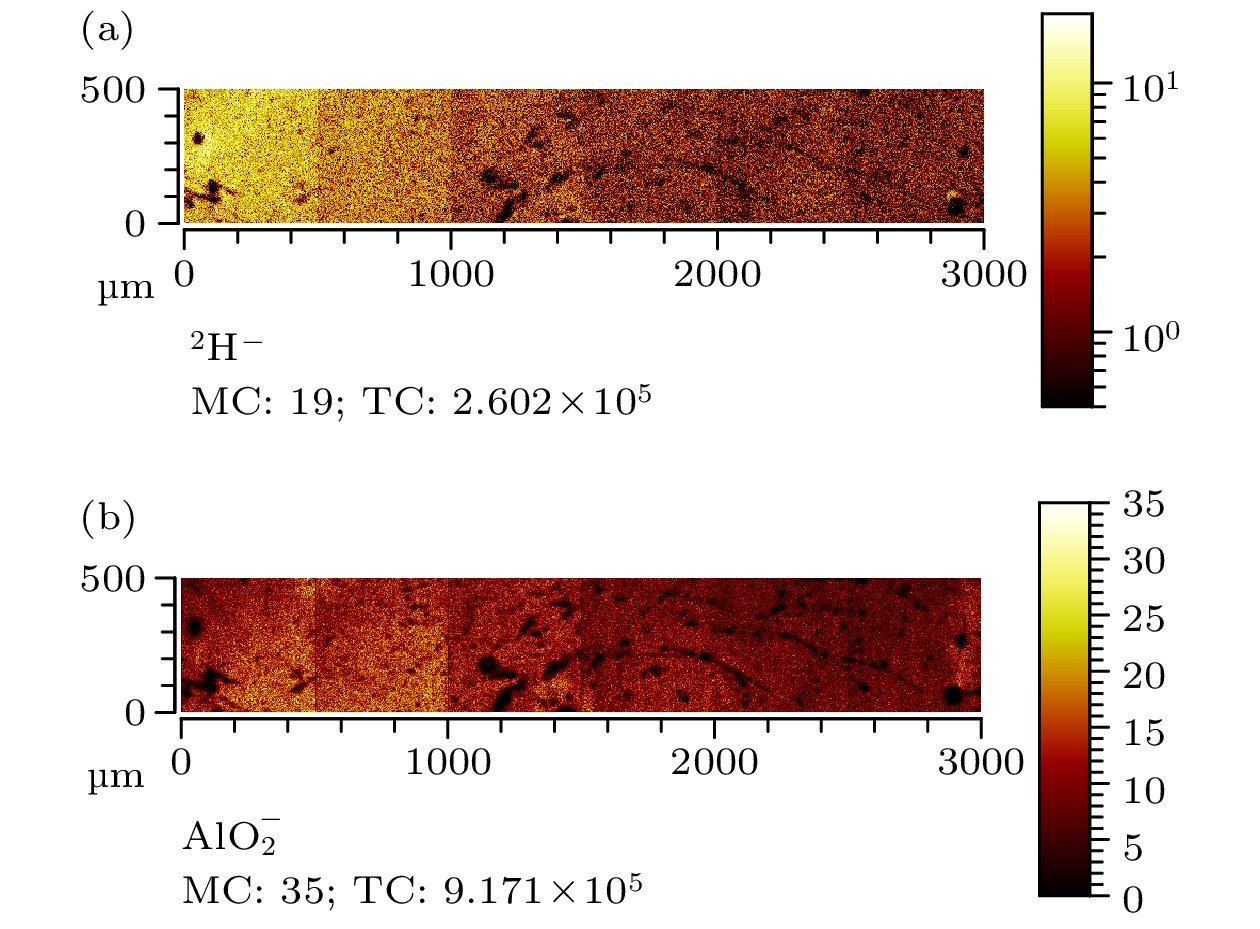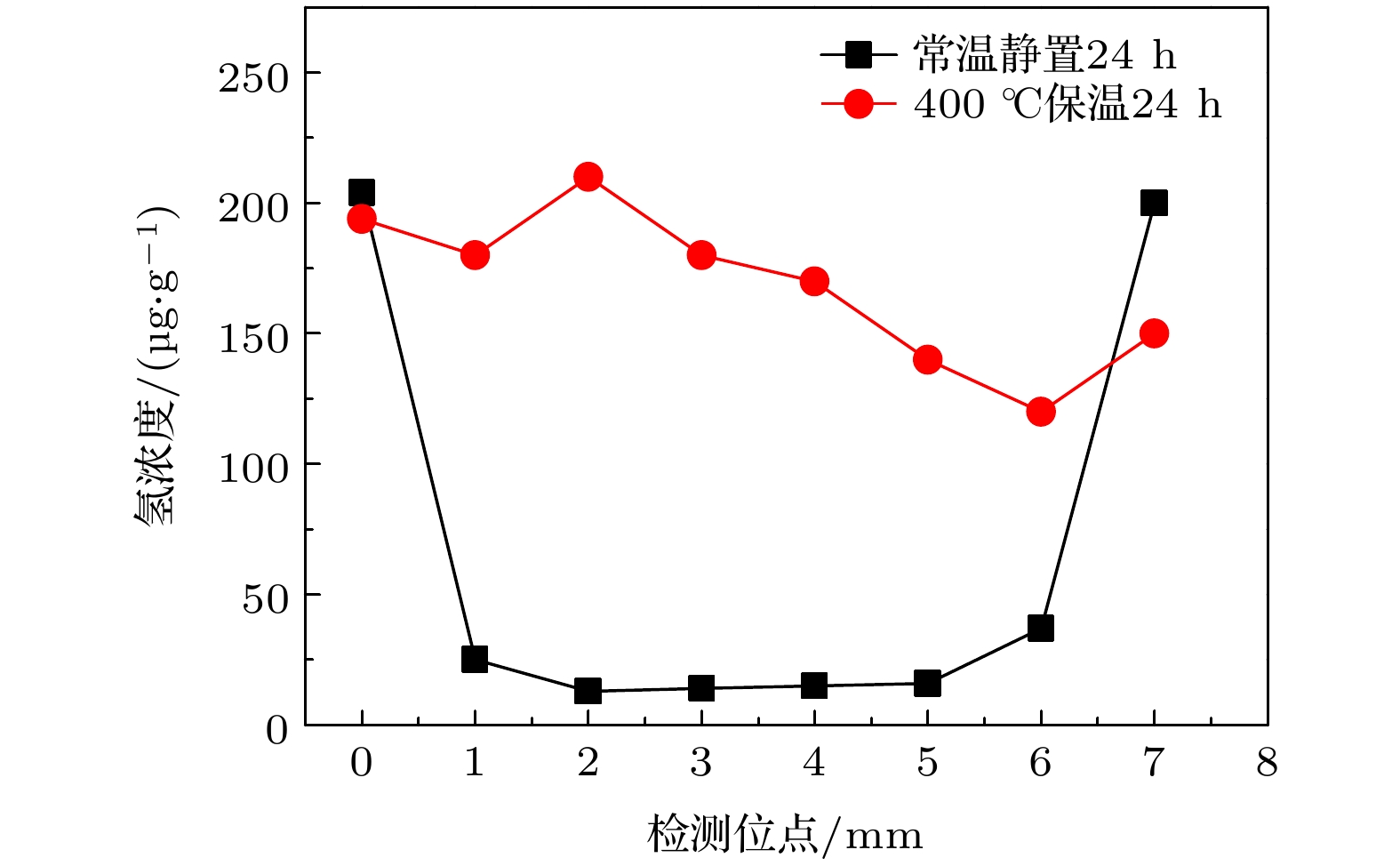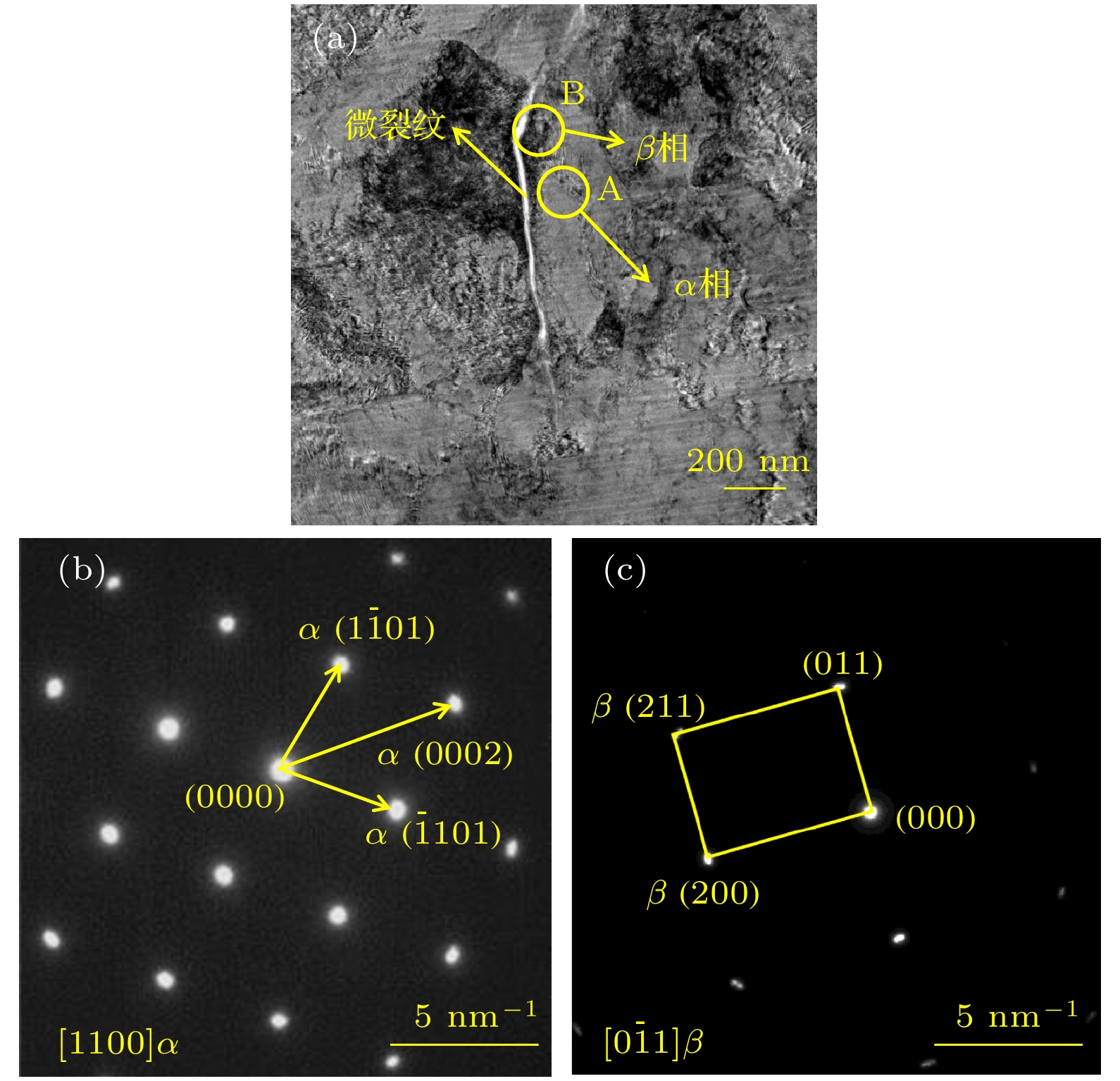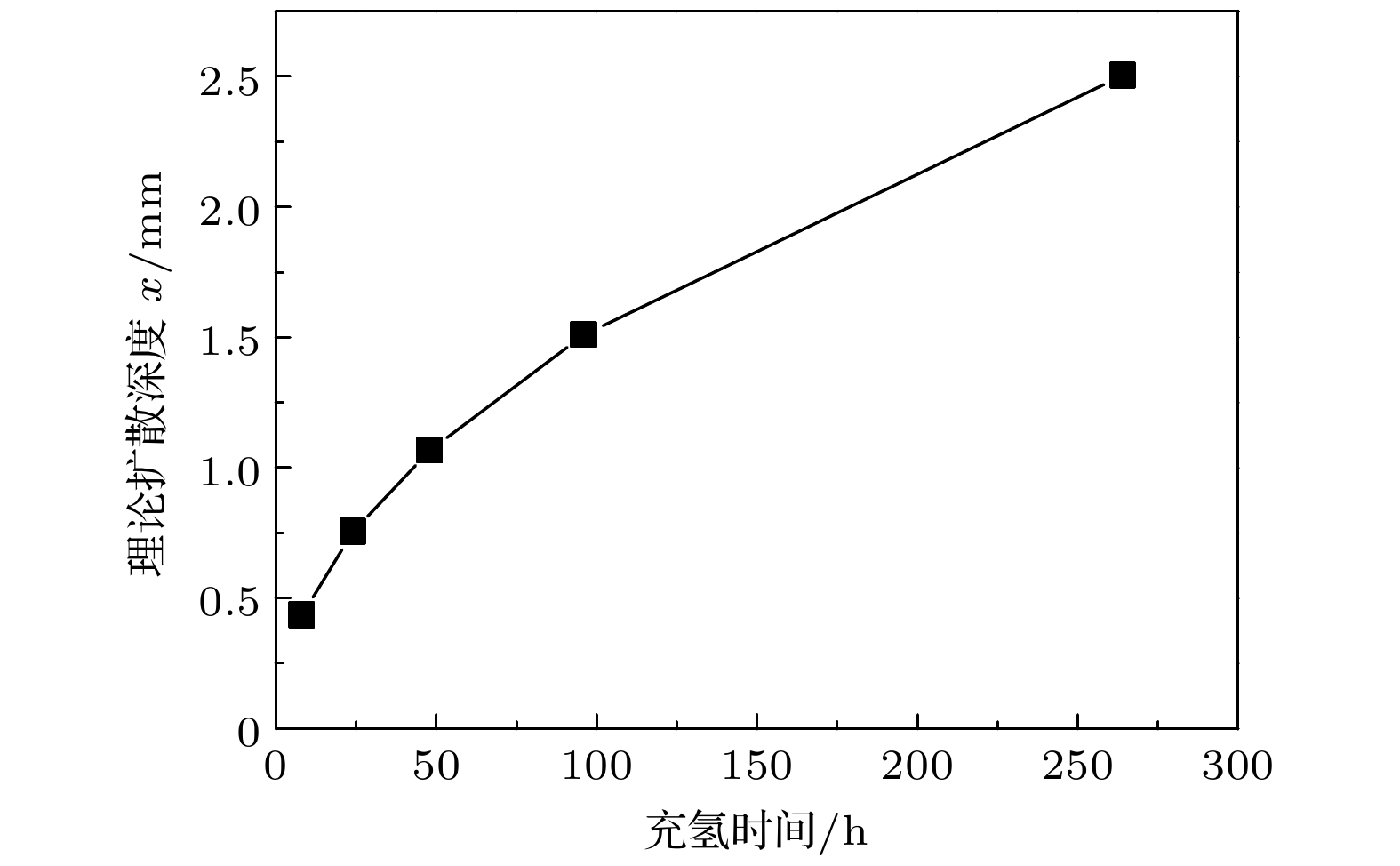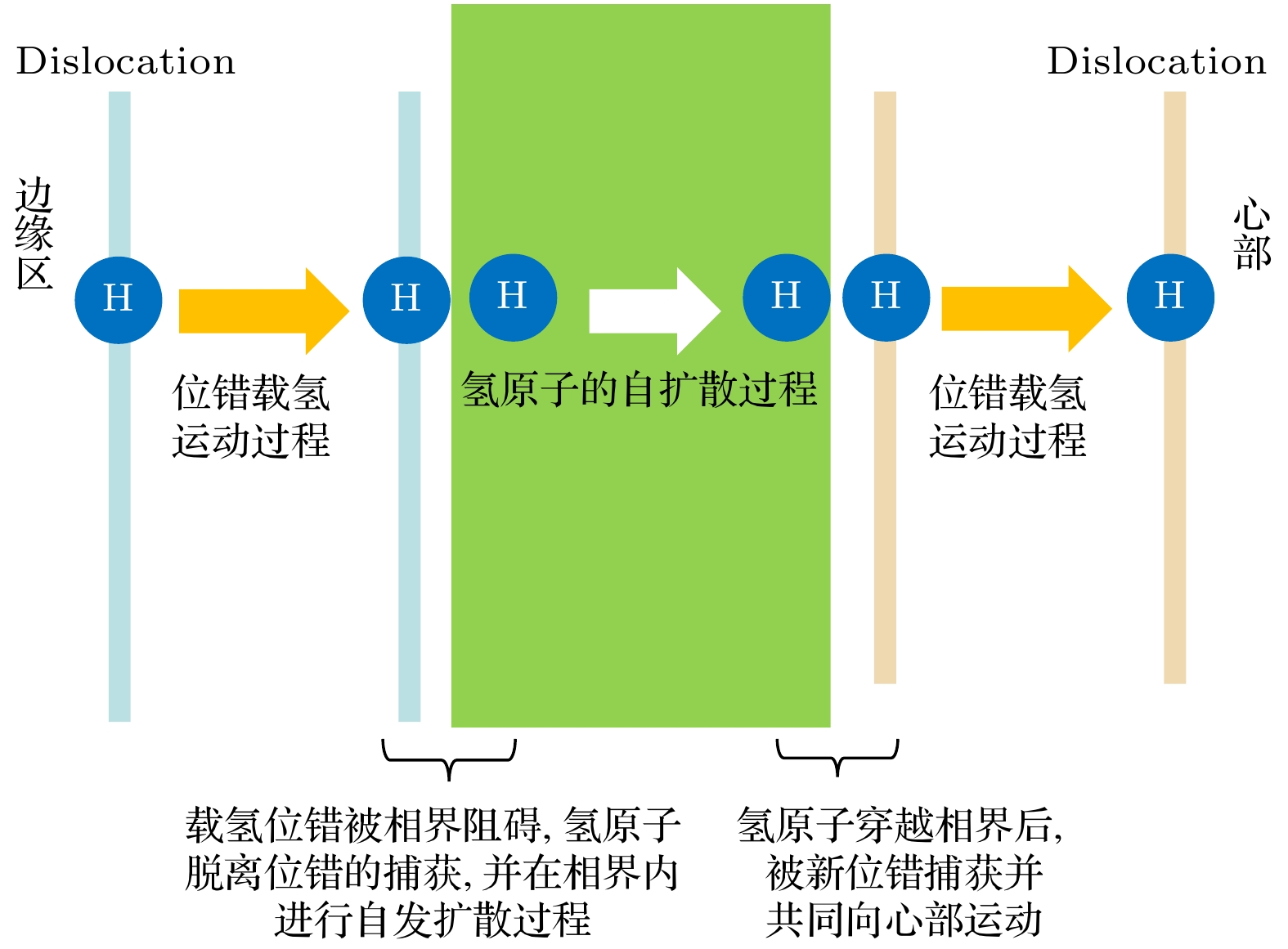-
The Ti-2.5Al-2Zr-1Fe used as hull structural material, is susceptible to hydrogen embrittlement induced by corrosion and hydrogen evolution in marine environments. Considering the long-term service of ships, the hydrogen embrittlement behavior under slow strain rate is crucial for evaluating the alloy’s service performance and ensuring long-term ship structural safety. In order to investigate the hydrogen embrittlement mechanism of Ti-2.5Al-2Zr-1Fe alloy under slow strain rate conditions, this study combines slow tension and constant displacement loading techniques to systematically evaluate the attenuation of mechanical properties and the dynamic changes in hydrogen embrittlement sensitivity of hydrogen-containing Ti-2.5Al-2Zr-1Fe alloy. Employing scanning electron microscopy (SEM), we thoroughly analyze the microstructural features of fracture surfaces. Meanwhile, the close correlation between the brittle zone at the fracture site and the macroscopic distribution of hydrogen atoms is elucidated by using secondary ion mass spectrometry (SIMS). Additionally, theoretical analysis based on diffusion equations reveals a notable increase in hydrogen diffusion distance within the Ti-2.5Al-2Zr-1Fe alloy as hydrogen charging time increases. Further, using the dislocation-hydrogen interaction model, we derive a critical strain rate threshold $ {\varepsilon _0} = {{\left( {30RT} \right)} {/ } {\left( {\rho DE} \right)}} $ for dislocation-mediated hydrogen transport in titanium alloys. When the externally applied strain rate ε falls below this threshold, dislocations efficiently capture and transport hydrogen atoms, enhancing hydrogen diffusion depth and significantly augmenting the alloy’s hydrogen embrittlement sensitivity, thereby accelerating material embrittlement. The Vickers-hardness (HV) test further elucidates the dual nature of hydrogen’s influence on titanium alloy properties: although moderate hydrogen content slightly enhances surface hardness, exceeding a specific threshold leads to a major negative influence on plasticity, far exceeding the benefits of surface hardening, resulting in a substantial decline in overall mechanical performance. To comprehensively decipher the hydrogen embrittlement mechanism of Ti-2.5Al-2Zr-1Fe alloy, transmission electron microscopy (TEM) is employed to analyze the phase composition in regions of high hydrogen concentration, crack tips, and their vicinities. The analysis results indicate that no direct precipitation of hydrides is observed; instead, hydrogen atoms preferentially accumulate in the β-phase, prompting microcrack propagation along β-phase boundaries. According to the aforementioned experimental data and microstructural analysis, we propose that the hydrogen embrittlement mechanism in Ti-2.5Al-2Zr-1Fe alloy is primarily governed by the HEDE mechanism. Furthermore, when the strain rate falls below ε0, it synergizes with the dislocation-mediated hydrogen transport mechanism, vastly expanding the influence scope of the HEDE mechanism and exacerbating the alloy’s hydrogen embrittlement sensitivity.
-
Keywords:
- titanium alloy /
- hydrogen embrittlement /
- slow strain rate /
- hydride
[1] 杨锐, 马英杰, 雷家峰, 胡青苗, 黄森森 2021 金属学报 57 1455
 Google Scholar
Google Scholar
Yang R, Ma Y J, Lei J F, Hu Q M, Huang S S 2021 Acta Metall. Sin. 57 1455
 Google Scholar
Google Scholar
[2] 何燕, 周刚, 刘艳侠, 王皞, 徐东生, 杨锐 2018 物理学报 67 050203
 Google Scholar
Google Scholar
He Y, Zhou G, Liu Y X, Wang H, Xu D S, Yang R 2018 Acta. Phys. Sin. 67 050203
 Google Scholar
Google Scholar
[3] 吴明宇, 弭光宝, 李培杰 2024 物理学报 73 086103
 Google Scholar
Google Scholar
Wu M Y, Mi G B, Li P J 2024 Acta. Phys. Sin. 73 086103
 Google Scholar
Google Scholar
[4] 丁智松, 高巍, 魏敬鹏, 金耀华, 赵晨, 杨巍 2022 物理学报 71 028102
 Google Scholar
Google Scholar
Ding Z S, Gao W, Wei J P, Jin Y H, Zhao C, Yang W 2022 Acta. Phys. Sin. 71 028102
 Google Scholar
Google Scholar
[5] Robertson I M, Sofronis P, Nagao A 2015 Metall. Mater. Trans. A 46 2323
 Google Scholar
Google Scholar
[6] Venezuela J, Zhou Q J, Liu Q L 2018 Mater. Today Commun. 17 1
 Google Scholar
Google Scholar
[7] Olden V, Thaulow C, Johnsen R 2008 Mater. Des. 29 1934
 Google Scholar
Google Scholar
[8] Lynch S P 2007 NACE International Corrosion Conference Nashville, Tennessee, March, 2007 p07493
[9] Wang X, Zhu R T, Li C Y, Wang X, Huang P F 2020 Rare Met. Mater. Eng. 49 3769
[10] Zhang S Q, Wan J F, Zhao Q Y 2020 Corros. Sci 164 108345
 Google Scholar
Google Scholar
[11] Xu Y L, Li L T 2021 Mater. Res. Express 8 046531
 Google Scholar
Google Scholar
[12] 汪洋, 吴冰, 宿彦京, 邢焰, 王向轲, 高鸿, 李岩 2020 有色金属工程 10 33
 Google Scholar
Google Scholar
Wang Y, Wu B, Su Y J, Xing Y, Wang X K, Gao H, Li Y 2020 Nonferrous Met. Eng. 10 33
 Google Scholar
Google Scholar
[13] Sun Z G, Hou H L 2008 J. Alloys Compd. 476 550
 Google Scholar
Google Scholar
[14] Liu X Y, Wang J, Gao L Q 2021 J. Alloys Compd. 862 158669
 Google Scholar
Google Scholar
[15] Tien J, Thompson A W, Bernstein I M 1976 Metall. Trans. A 7 821
 Google Scholar
Google Scholar
[16] 吴明宇, 弭光宝, 李培杰, 黄旭 2023 物理学报 72 166102
 Google Scholar
Google Scholar
Wu M Y, Mi G B, Li P J, Huang X 2023 Acta Phys. Sin. 72 166102
 Google Scholar
Google Scholar
[17] 周伟, 姚泽坤, 谭立军, 郭鸿镇, 张建伟, 梁晓波 2011 稀有金属材料与工程 40 1230
Zhou W, Yao Z K, Tan L J, Guo H Z, Zhang J W, Liang X B 2011 Rare Met. Mater. Eng. 40 1230
[18] 赵晓丽, 张永健, 邵成伟, 惠卫军, 董瀚 2018 金属学报 54 1031
 Google Scholar
Google Scholar
Zhao X L, Zhang Y J, Shao C W, Hui W J, Dong H 2018 Acta Metall. Sin. 54 1031
 Google Scholar
Google Scholar
[19] 张滨, 郑华, 刘实, 王隆保 2005 原子能科学技术 39 522
 Google Scholar
Google Scholar
Zhang B, Zheng H, Liu S, Wang L B 2005 At. Energy Sci. Technol. 39 522
 Google Scholar
Google Scholar
[20] Chen C Q, Li S X, Lu K 2003 Acta Mater. 51 931
 Google Scholar
Google Scholar
[21] 王艳飞, 巩建鸣, 蒋文春, 姜勇, 唐建群 2011 金属学报 47 594
Wang Y F, Gong J M, Jiang W C, Jiang Y, Tang J Q 2011 Acta Metall. Sin. 47 594
[22] 刘战伟 2009 桂林电子科技大学学报 29 108
 Google Scholar
Google Scholar
Liu Z W 2009 J. Guilin Univ. Electron. Technol. 29 108
 Google Scholar
Google Scholar
[23] 孙志杰, 王洋 2020 材料开发与应用 35 94
Sun Z J, Wang Y 2020 Dev. Appl. Mater. 35 94
[24] 刘晓镇, 韩恩厚, 宋影伟 2023 中国有色金属学报 33 307
 Google Scholar
Google Scholar
Liu X Z, Han E H, Song Y W 2023 Chin. J. Nonferrous Met. 33 307
 Google Scholar
Google Scholar
[25] 王秀英, 孙力玲, 刘日平, 姚玉书, 张君, 王文魁 2004 物理学报 53 3845
 Google Scholar
Google Scholar
Wang X Y, Sun L L, Liu R P, Yao Y S, Zhang J, Wang W K 2004 Acta Phys. Sin. 53 3845
 Google Scholar
Google Scholar
[26] 孙永伟, 陈继志, 刘军 2015 金属学报 51 1315
Sun Y W, Chen J Z, Liu J 2015 Acta Metall. Sin. 51 1315
[27] 李洪佳, 孙光爱, 龚建, 陈波, 王虹, 李建, 庞蓓蓓, 张莹, 彭述明 2014 物理学报 63 236101
 Google Scholar
Google Scholar
Li H J, Sun G A, Gong J, Chen B, Wang H, Li J, Pang B B, Zhang Y, Peng S M 2014 Acta Phys. Sin. 63 236101
 Google Scholar
Google Scholar
[28] Kan B, Wu W J, Yang Z X, Li J X 2020 Mater. Sci. Eng. A 775 138963
 Google Scholar
Google Scholar
[29] Wang M Q, Akiyama E, Tsuzaki K 2007 Corros. Sci. 49 4081
 Google Scholar
Google Scholar
[30] 王贞, 刘静, 张施琦, 黄峰 2022 中国腐蚀与防护学报 42 106
 Google Scholar
Google Scholar
Wang Z, Liu J, Zhang S Q, Huang F 2022 J. Chin. Soc. Corros. Prot. 42 106
 Google Scholar
Google Scholar
-
表 1 二次离子质谱测试参数
Table 1. Parameters of SIMS testing.
入射能量/keV 入射角/(°) 电流强度/pA 扫描面积/m2 极性及质量范围/amu 30 45 1.142 500×500 负离子模式 0—227 -
[1] 杨锐, 马英杰, 雷家峰, 胡青苗, 黄森森 2021 金属学报 57 1455
 Google Scholar
Google Scholar
Yang R, Ma Y J, Lei J F, Hu Q M, Huang S S 2021 Acta Metall. Sin. 57 1455
 Google Scholar
Google Scholar
[2] 何燕, 周刚, 刘艳侠, 王皞, 徐东生, 杨锐 2018 物理学报 67 050203
 Google Scholar
Google Scholar
He Y, Zhou G, Liu Y X, Wang H, Xu D S, Yang R 2018 Acta. Phys. Sin. 67 050203
 Google Scholar
Google Scholar
[3] 吴明宇, 弭光宝, 李培杰 2024 物理学报 73 086103
 Google Scholar
Google Scholar
Wu M Y, Mi G B, Li P J 2024 Acta. Phys. Sin. 73 086103
 Google Scholar
Google Scholar
[4] 丁智松, 高巍, 魏敬鹏, 金耀华, 赵晨, 杨巍 2022 物理学报 71 028102
 Google Scholar
Google Scholar
Ding Z S, Gao W, Wei J P, Jin Y H, Zhao C, Yang W 2022 Acta. Phys. Sin. 71 028102
 Google Scholar
Google Scholar
[5] Robertson I M, Sofronis P, Nagao A 2015 Metall. Mater. Trans. A 46 2323
 Google Scholar
Google Scholar
[6] Venezuela J, Zhou Q J, Liu Q L 2018 Mater. Today Commun. 17 1
 Google Scholar
Google Scholar
[7] Olden V, Thaulow C, Johnsen R 2008 Mater. Des. 29 1934
 Google Scholar
Google Scholar
[8] Lynch S P 2007 NACE International Corrosion Conference Nashville, Tennessee, March, 2007 p07493
[9] Wang X, Zhu R T, Li C Y, Wang X, Huang P F 2020 Rare Met. Mater. Eng. 49 3769
[10] Zhang S Q, Wan J F, Zhao Q Y 2020 Corros. Sci 164 108345
 Google Scholar
Google Scholar
[11] Xu Y L, Li L T 2021 Mater. Res. Express 8 046531
 Google Scholar
Google Scholar
[12] 汪洋, 吴冰, 宿彦京, 邢焰, 王向轲, 高鸿, 李岩 2020 有色金属工程 10 33
 Google Scholar
Google Scholar
Wang Y, Wu B, Su Y J, Xing Y, Wang X K, Gao H, Li Y 2020 Nonferrous Met. Eng. 10 33
 Google Scholar
Google Scholar
[13] Sun Z G, Hou H L 2008 J. Alloys Compd. 476 550
 Google Scholar
Google Scholar
[14] Liu X Y, Wang J, Gao L Q 2021 J. Alloys Compd. 862 158669
 Google Scholar
Google Scholar
[15] Tien J, Thompson A W, Bernstein I M 1976 Metall. Trans. A 7 821
 Google Scholar
Google Scholar
[16] 吴明宇, 弭光宝, 李培杰, 黄旭 2023 物理学报 72 166102
 Google Scholar
Google Scholar
Wu M Y, Mi G B, Li P J, Huang X 2023 Acta Phys. Sin. 72 166102
 Google Scholar
Google Scholar
[17] 周伟, 姚泽坤, 谭立军, 郭鸿镇, 张建伟, 梁晓波 2011 稀有金属材料与工程 40 1230
Zhou W, Yao Z K, Tan L J, Guo H Z, Zhang J W, Liang X B 2011 Rare Met. Mater. Eng. 40 1230
[18] 赵晓丽, 张永健, 邵成伟, 惠卫军, 董瀚 2018 金属学报 54 1031
 Google Scholar
Google Scholar
Zhao X L, Zhang Y J, Shao C W, Hui W J, Dong H 2018 Acta Metall. Sin. 54 1031
 Google Scholar
Google Scholar
[19] 张滨, 郑华, 刘实, 王隆保 2005 原子能科学技术 39 522
 Google Scholar
Google Scholar
Zhang B, Zheng H, Liu S, Wang L B 2005 At. Energy Sci. Technol. 39 522
 Google Scholar
Google Scholar
[20] Chen C Q, Li S X, Lu K 2003 Acta Mater. 51 931
 Google Scholar
Google Scholar
[21] 王艳飞, 巩建鸣, 蒋文春, 姜勇, 唐建群 2011 金属学报 47 594
Wang Y F, Gong J M, Jiang W C, Jiang Y, Tang J Q 2011 Acta Metall. Sin. 47 594
[22] 刘战伟 2009 桂林电子科技大学学报 29 108
 Google Scholar
Google Scholar
Liu Z W 2009 J. Guilin Univ. Electron. Technol. 29 108
 Google Scholar
Google Scholar
[23] 孙志杰, 王洋 2020 材料开发与应用 35 94
Sun Z J, Wang Y 2020 Dev. Appl. Mater. 35 94
[24] 刘晓镇, 韩恩厚, 宋影伟 2023 中国有色金属学报 33 307
 Google Scholar
Google Scholar
Liu X Z, Han E H, Song Y W 2023 Chin. J. Nonferrous Met. 33 307
 Google Scholar
Google Scholar
[25] 王秀英, 孙力玲, 刘日平, 姚玉书, 张君, 王文魁 2004 物理学报 53 3845
 Google Scholar
Google Scholar
Wang X Y, Sun L L, Liu R P, Yao Y S, Zhang J, Wang W K 2004 Acta Phys. Sin. 53 3845
 Google Scholar
Google Scholar
[26] 孙永伟, 陈继志, 刘军 2015 金属学报 51 1315
Sun Y W, Chen J Z, Liu J 2015 Acta Metall. Sin. 51 1315
[27] 李洪佳, 孙光爱, 龚建, 陈波, 王虹, 李建, 庞蓓蓓, 张莹, 彭述明 2014 物理学报 63 236101
 Google Scholar
Google Scholar
Li H J, Sun G A, Gong J, Chen B, Wang H, Li J, Pang B B, Zhang Y, Peng S M 2014 Acta Phys. Sin. 63 236101
 Google Scholar
Google Scholar
[28] Kan B, Wu W J, Yang Z X, Li J X 2020 Mater. Sci. Eng. A 775 138963
 Google Scholar
Google Scholar
[29] Wang M Q, Akiyama E, Tsuzaki K 2007 Corros. Sci. 49 4081
 Google Scholar
Google Scholar
[30] 王贞, 刘静, 张施琦, 黄峰 2022 中国腐蚀与防护学报 42 106
 Google Scholar
Google Scholar
Wang Z, Liu J, Zhang S Q, Huang F 2022 J. Chin. Soc. Corros. Prot. 42 106
 Google Scholar
Google Scholar
Catalog
Metrics
- Abstract views: 3620
- PDF Downloads: 97
- Cited By: 0















 DownLoad:
DownLoad:
